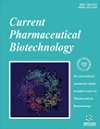- Home
- A-Z Publications
- Current Pharmaceutical Biotechnology
- Previous Issues
- Volume 24, Issue 7, 2023
Current Pharmaceutical Biotechnology - Volume 24, Issue 7, 2023
Volume 24, Issue 7, 2023
-
-
Noncoding RNA Databases
More LessBy Jens AllmerDiseases such as cancer are often defined by dysregulation of gene expression. Noncoding RNAs (ncRNA) such as microRNAs are involved in gene expression and cell-cell communication. Many other ncRNAs exist, such as circular RNAs and small nucleolar RNAs. A wealth of knowledge is available for many ncRNAs, but the information is federated in many databases. A small number of highly complementary ncRNA datab Read More
-
-
-
New Era on Combining Both Imaging and Drug Delivery to Treat Cancer
More LessIt is well documented that cancer is one of the leading causes of death worldwide. During the pandemic, cancer screening was suspended, and only symptomatic patients were referred for screening. It is believed that deaths related to various cancer types have increased by around 10%, and the screening suspension was assumed as the main reason. It is well documented that the early diagnosis of cancer is important for the Read More
-
-
-
Noncoding RNAs: A New Layer of Functional RNAs
More LessAuthors: Dilek C. Gurer and Bünyamin AkgülThe conventional central dogma of molecular biology dictates that the genetic information contained within deoxyribonucleic acid (DNA) is passed onto messenger ribonucleic acids (mRNAs), which are then used as templates to synthesize proteins. Although these types of proteincoding genes have been historically prioritized in typical phenotype-genotype studies with a parallel disregard to the rest of the genome, the completi Read More
-
-
-
Long Noncoding RNAs in Human Cancer and Apoptosis
More LessAuthors: İpek Erdoğan, Osama Sweef and Bünyamin AkgülGenome annotations have uncovered the production of at least one transcript from nearly all loci in the genome at some given time throughout the development. Surprisingly, many of these transcripts do not code for proteins and are relatively long in size, thus called long noncoding RNAs (lncRNAs). Next- and third-generation sequencing technologies have amassed numerous lncRNAs expressed under different phenotypic Read More
-
-
-
Involvement of Metabolites and Non-coding RNAs in Diseases
More LessAuthors: Kubra A. Coskun, Bercem Y. Kıyak, Kezban Ucar Cifci, Elif Kadioglu, Nazlican Yurekli and Yusuf TutarNon-coding RNAs have a role in gene regulation and cellular metabolism control. Metabolism produces metabolites which are small molecules formed during the metabolic process. So far, a direct relationship between metabolites and genes is not fully established; however, pseudogenes and their progenitor genes regulate health and disease states. Other non-coding RNAs also contribute to this regulation at different cellu Read More
-
-
-
MicroRNAs and Long Non-coding RNAs as Novel Targets in Anti-cancer Drug Development
More LessAuthors: Melisa tinkaya and Yusuf BaranNon-coding RNAs comprise the majority of RNAs that have been transcribed from the human genome, and these non-coding RNAs have essential regulatory roles in the cellular processes. They have been discovered to influence the expression of the genes, including tumorsuppressive and oncogenes, that establish the non-coding RNAs as novel targets for anti-cancer drug development. Among non-coding RNAs, microRNAs Read More
-
Volumes & issues
-
Volume 26 (2025)
-
Volume 25 (2024)
-
Volume 24 (2023)
-
Volume 23 (2022)
-
Volume 22 (2021)
-
Volume 21 (2020)
-
Volume 20 (2019)
-
Volume 19 (2018)
-
Volume 18 (2017)
-
Volume 17 (2016)
-
Volume 16 (2015)
-
Volume 15 (2014)
-
Volume 14 (2013)
-
Volume 13 (2012)
-
Volume 12 (2011)
-
Volume 11 (2010)
-
Volume 10 (2009)
-
Volume 9 (2008)
-
Volume 8 (2007)
-
Volume 7 (2006)
-
Volume 6 (2005)
-
Volume 5 (2004)
-
Volume 4 (2003)
-
Volume 3 (2002)
-
Volume 2 (2001)
-
Volume 1 (2000)
Most Read This Month
Article
content/journals/cpb
Journal
10
5
false
en


